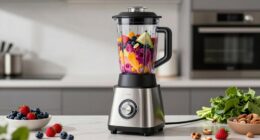I constantly immerse myself in the rich flavors and culinary traditions of France as a lover of French cuisine. Butter is a key ingredient that is frequently used in French kitchens.
But have you ever wondered how to say butter in French? In this article, I will guide you through the common French words for butter, provide pronunciation tips, and even introduce you to some delectable French butter brands.
So, let’s dive into the world of butter in French cuisine!
Key Takeaways
- Understanding French culinary terms is essential for appreciating French cuisine.
- Butter is a fundamental ingredient in French cooking.
- In French, butter is pronounced as ‘beurre’.
- Butter plays a crucial role in French recipes.
The Importance of Knowing French Culinary Terms
Knowing culinary terms in French is important if you want to understand and appreciate French cuisine. One of the most essential ingredients in French cooking is butter. In French, butter is called ‘beurre.’
The cultural significance of butter in French cooking cannot be understated. It is a fundamental component in many traditional French dishes, such as croissants, beurre blanc sauce, and escargots de Bourgogne. Butter adds richness, creaminess, and depth of flavor to these dishes. It is also used as a cooking medium, providing a delicious base for sautéing vegetables and searing meats.
The French have a long-standing love affair with butter, and its presence in their cuisine reflects their appreciation for indulgence, richness, and the art of gastronomy. So, if you want to fully embrace and understand French cuisine, learning the term ‘beurre’ is a must.
Common French Words for Butter
In French, one can use the word ‘beurre’ to refer to butter. The pronunciation guide for ‘beurre’ is /bœʁ/.
As a native French speaker, I can attest to the cultural significance of this word. Butter plays a crucial role in French cuisine, adding richness and flavor to many dishes. From croissants to sauces, beurre is a staple ingredient that cannot be overlooked. Its creamy texture and distinct taste make it a beloved ingredient in French cooking.
The word ‘beurre’ is also used in several idiomatic expressions, such as ‘mettre du beurre dans les épinards’, which means to improve one’s financial situation.
Understanding the word ‘beurre’ and its cultural significance is essential for anyone looking to fully immerse themselves in French language and cuisine.
Pronunciation Tips for Saying Butter in French
When it comes to pronouncing butter in French, there are a few key points to keep in mind.
French butter is pronounced as ‘beurre’, with the ‘eu’ sound similar to the ‘u’ in ‘but’. It’s important to note that the ‘r’ at the end is not pronounced in French.
On the other hand, when it comes to common butter pronunciations in English, it is typically pronounced as ‘buh-ter’, with a short ‘u’ sound followed by a soft ‘t’ and ‘er’ sound.
French Butter Pronunciation
The pronunciation of butter in French is ‘beurre’. When it comes to French cuisine, butter plays a crucial role in many traditional recipes.
However, if you’re looking for alternatives to butter in French cooking, there are a few options to consider.
One popular alternative is margarine, which is often used as a substitute in baking or spreading on bread.
Another option is olive oil, which can be used as a healthier alternative in certain recipes.
Additionally, coconut oil can be used as a substitute for butter in vegan or dairy-free recipes.
It’s important to note that while these alternatives can work well in some dishes, they may not provide the exact same flavor and texture as traditional butter.
Common Butter Pronunciations
One popular option for butter pronunciation in French is ‘beurre’. It is a commonly used term in France to refer to butter. However, there are other variations and alternatives that can be used as well. Here are four common pronunciations for butter in French:
- ‘Bur’: This is a simplified pronunciation that is often used in casual conversations.
- ‘Beur’: This pronunciation is commonly used in some regions of France, particularly in the north.
- ‘Bu-ter’: This is a more anglicized version of the word, often used by English speakers.
- ‘Matière grasse’: Literally translating to ‘fat substance,’ this is a more formal way to refer to butter in French.
When it comes to butter etiquette in France, it is important to note that it is typically served at room temperature and is spread on bread using a butter knife. It is considered impolite to take a bite directly from a butter stick.
Butter Substitutes in French Cuisine
When it comes to French cooking, butter is often a staple ingredient. However, there are alternative fats that can be used to achieve the desired flavors and textures in dishes.
In addition, for those following a vegan diet, there are various options available for vegan butter that can be used in traditional French recipes.
In this discussion, we will explore alternative French cooking fats and delve into the world of vegan butter options for a delicious and inclusive culinary experience.
Alternative French Cooking Fats
If you’re looking for an alternative to butter in French cooking, you can try using olive oil or duck fat. Here are some options to consider:
-
Coconut oil: This vegan alternative adds a subtle tropical flavor to your dishes and has numerous health benefits, such as boosting metabolism and promoting heart health.
-
Avocado oil: Known for its high smoke point, avocado oil is perfect for sautéing and frying. It is rich in monounsaturated fats, which can help lower cholesterol levels and reduce inflammation.
-
Nut oils, like walnut or almond oil: These oils add a nutty flavor to your dishes and are packed with essential fatty acids, antioxidants, and vitamins.
-
Vegetable shortening: While not as healthy as some other options, vegetable shortening can be used in baking to create a flaky texture in pastries and pie crusts.
Vegan Butter Options
To make vegan butter, you can blend together a combination of plant-based oils, such as coconut oil and olive oil. These vegan butter alternatives are not only delicious but also a healthier option for those who follow a plant-based diet or have dietary restrictions. In French cuisine, where butter is a staple ingredient, finding suitable alternatives can be a challenge. However, with the rise in popularity of veganism, there are now several options available. One popular vegan butter option is made from a combination of coconut oil, olive oil, and non-dairy milk. This blend creates a creamy and spreadable texture that can be used in a variety of French dishes. Another alternative is using nut-based butters, such as almond or cashew butter, which provide a rich and nutty flavor. These vegan butter alternatives allow for the enjoyment of French cuisine without sacrificing taste or dietary preferences.
| Vegan Butter Alternatives | Usage in French Cuisine |
|---|---|
| Coconut oil and olive oil | Used for baking and cooking |
| Non-dairy milk and oils | Perfect for spreading on bread or toast |
| Nut-based butters | Great for making sauces and dressings |
| Vegetable oil and non-dairy yogurt | Ideal for sautéing and frying |
Butter in French Baking and Pastry
Butter is an essential ingredient in French baking and pastry. As a baker, I rely on butter for its rich flavor and creamy texture. Here are a few things I’ve learned about butter in French cooking:
-
Butter Measurement Conversions: In France, butter is typically measured by weight rather than volume. One stick of butter equals 113 grams, or approximately 1/2 cup.
-
Beurre Noisette: This is a traditional French browned butter, which adds a nutty flavor to pastries and sauces. To make beurre noisette, simply melt butter over medium heat until it turns a golden brown color.
-
Beurre Blanc: This is a classic French butter sauce made by whisking cold butter into a reduction of white wine, vinegar, and shallots. It is commonly served with fish or seafood.
-
Croissants: French croissants are famous for their flaky layers, which are created by incorporating layers of butter into the dough through a process called lamination.
These traditional French butter dishes and techniques add depth and richness to French baking and pastry, making them truly special.
French Butter Brands to Try
When exploring French baking and pastry, you’ll want to try out different brands of butter. French butter is known for its high quality and rich flavor, making it a key ingredient in many traditional French recipes.
Some popular French butter brands to consider are Beurre d’Isigny, Beurre de Baratte, and Echiré. These brands are known for using traditional methods of production, resulting in a butter that is creamy, smooth, and full of flavor.
French butter is also prized for its health benefits. It is rich in vitamin A, which is important for maintaining healthy skin and vision. Additionally, it is a good source of healthy fats and contains a higher percentage of fat compared to butter from other countries.
Butter-Based French Sauces and Spreads
If you’re looking to add depth and flavor to your dishes, consider exploring the world of butter-based French sauces and spreads. French cuisine is renowned for its rich and indulgent flavors, and butter plays a crucial role in achieving that.
Here are four delicious uses of butter in French cuisine:
-
Beurre Blanc: This classic French sauce is made by emulsifying butter into a reduction of white wine, vinegar, and shallots. It pairs perfectly with fish and seafood.
-
Beurre Noisette: Also known as brown butter, this nutty and fragrant sauce is made by cooking butter until it turns a golden brown color. It adds a unique flavor to vegetables, pasta, and desserts.
-
Béarnaise Sauce: This velvety sauce is made by whisking melted butter into a reduction of white wine, vinegar, shallots, and tarragon. It is commonly served with steak.
-
Compound Butter: This versatile spread is made by mixing butter with various herbs, spices, and other ingredients. It can be used to add flavor to grilled meats, roasted vegetables, or as a finishing touch to butter-based desserts.
Exploring these butter-based French sauces and spreads will elevate your cooking and transport you to the heart of French cuisine.
French Butter Etiquette and Customs
Learning about French butter etiquette and customs can enhance your culinary experience and immerse you in the traditions of French cuisine. French cuisine is known for its rich and flavorful butter-based recipes. However, it’s not just about the taste; it’s also about the way butter is used and appreciated in French culture.
In French cuisine, butter is considered a staple ingredient and is used in a variety of dishes, from sauces and spreads to pastries and bread. The French take their butter seriously and have developed certain customs and etiquette around its use. For example, it is customary to serve butter at room temperature, allowing it to soften and become easily spreadable. It is also common to use a butter dish or a special butter knife when serving butter at the table.
To highlight the importance of butter in French cuisine, here is a table showcasing some popular French butter recipes:
| Recipe | Description | Ingredients |
|---|---|---|
| Beurre Blanc | Classic French butter sauce | Butter, white wine, shallots |
| Croissant | Iconic French pastry | Butter, flour, yeast |
| Beurre Noisette | Nutty and flavorful browned butter | Butter |
Frequently Asked Questions
What Are Some Common French Culinary Terms Other Than Those Related to Butter?
Incorporating French culinary terms in everyday cooking can elevate your dishes. From "sauté" to "bouillabaisse," these terms add a touch of elegance. Fine dining establishments often use terms like "amuse-bouche" and "mise en place" to create a refined dining experience.
Are There Any Specific Tips for Pronouncing French Culinary Terms Correctly?
When it comes to pronouncing French culinary terms, there are some useful techniques. One tip is to practice the specific sounds of the French language, like the "r" and nasal vowels. Another is to listen to native speakers and imitate their pronunciation.
What Are Some Common Substitutions for Butter That Are Used in French Cuisine?
In French cuisine, there are several common substitutions for butter. Some healthy alternatives include olive oil and avocado. For a vegan-friendly option, margarine or coconut oil can be used.
What Are Some Popular French Baking and Pastry Recipes That Use Butter?
French pastry techniques involve the use of butter in various popular baking recipes. Traditional French butter croissants are a prime example. The rich and flaky texture of these pastries is achieved through the incorporation of high-quality butter.
Can You Recommend Any French Butter Brands That Are Known for Their Quality?
When it comes to French butter brands, choosing the best one for your recipes can be a delicious challenge. However, if you’re looking for alternative options in French cuisine, don’t forget about the amazing butter-based desserts and pastries in French baking.
Conclusion
In conclusion, I’ve learned that butter is an essential ingredient in French cuisine. Knowing how to say it correctly in French is important for any aspiring chef or food enthusiast.
Interestingly, France is the largest consumer of butter in the world. On average, each person consumes 8.2 kilograms of butter per year. This statistic highlights the significance of butter in French cooking and the rich culinary traditions associated with it.
So, whether you’re indulging in French pastries or creating savory dishes, mastering the word ‘butter’ in French will enhance your gastronomic experience.









